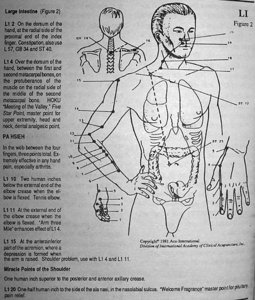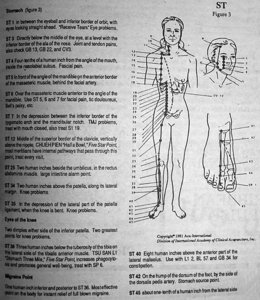Allow me to say "Thank you" for the positive comments and reports of cases which were helped through the words and thoughts of this column from around the world. Even though I receive letters on a daily basis from all parts of the globe filling me in on a particular case which totally turned around with the administration of simple stimulation to some of the reflex points we discuss in this column, one of the most exciting and, without question, most frequently reported turn arounds is the proper positioning of a fetus which had earlier been in the breech position.
In the February 28, 1990 issue of Dynamic Chiropractic I wrote an article which mentioned 91 specific miracle points for specific conditions. The 90th one reported was a point referred to as "hsiaochihchien" which is located at the tip end of the small toe bilaterally which was reported to turn an inverted fetus and difficult labor.
Little did I realize when I wrote that article how many lives would be touched by sharing that small bit of information. I have received, conservatively estimating, a minimum of 25 letters of thanks from DCs who used this technique with nothing more than their fingertips or simply advised the patient to rub her own toe for a successful outcome usually within 24 hours of stimulation.
I can hear it now, about 5,000 of you around the world are saying "C'mon, Amaro, give me a break that's impossible!" To which I fully agree; it sounds pretty flaky. However, don't blame the messenger for the message.
I have absolutely no idea how this point works and I publicly admit to the entire profession I really don't know how the vast majority of acupuncture works. However, what I do know is pretty significant thanks to all of my teachers around the world. One thing you have to remember about this article is what I report has been said earlier by some of the most dynamic minds of this and of past centuries. Very little if any is original. Thank God I couldn't stand he ego trip to discover a point which would reverse an inverted fetus.
What I am about to report to you in this upcoming series of articles are specific notes on 117 acupuncture points which are the most significant points on the 14 major meridians. This series of articles should be considered as extremely important. You are highly advised to retain each article of this series for your file.
The notes you will be given here is a mini seminar in itself; it totally depends on you what you will do with it. Study the graphics and the notes attached to each point. Keep in mind some of the terminologies employed may not mean anything to you yet, but will be fully explained as we move through the series.
Remember, any acupoint may be stimulated with anything as long as one stimulates. Electronic, laser, non invasive pressure device (teishein), and needle may be used; however, rank neophytes are strongly cautioned to forget the needles in lieu of something a little safer to use. Pressure is adequate. Don't forget to clip this article as well as all future ones.
Lung (lung meridian controls skin) (Figure I)
LU 1 In the lateral part of the 1st intercostal space, near the coracoid process. Lung alarm point, sore to the touch in the respiratory patient.
LU 5 At the elbow crease on the lateral border of the tendon of the biceps brachii muscle. Chronic cough.
LU 7 1.5 human inches above the most distal skin crease of the wrist, above the styloid process of the radius. Migraine, Five Star Point, master point for head and neck, LUO point for lung meridian.
LU 9 On the palmar surface at the middle of the first metacarpal bone. Lung source point.

Large Intestine (Figure 2)
L1 2 On the dorsum of the hand, at the radial side of the proximal end of the index finger. Constipation, also use L 57, GB 34 and ST 40.
L1 4 Over the dorsum of the hand, between the first and second metacarpal bones, on the protuberance of the muscle on the radial side of the middle of the second metacarpal bone. HOKU "Meeting of the Valley," Five Star Point, master point for upper extremity, head and neck, dental analgesic point.
PA HSIEH
In the web between the four fingers, three points total. Extremely effective in any hand pain, especially arthritis.
L1 10 Two human inches below the external end of the elbow crease when the elbow is flexed. Tennis elbow.
L1 11 At the external end of the elbow crease when the elbow is flexed. "Arm three Mile" enhances effect of L1 4.
L1 15 At the anteroinferior part of the acromion, where a depression is formed when the arm is raised. Shoulder problem, use with L1 4 and L1 11.
Miracle Points of the Shoulder
One human inch superior to the posterior and anterior axillary crease.
L1 20 One-half human inch to the side of the ala nasi, in the nasolabial sulcus. "Welcome Fragrance" master point for pituitary, pain relief.

Stomach (figure 3)
ST 1 in between the eyeball and inferior border of orbit, with eyes looking straight ahead. "Receive Tears" Eye problems.
ST 3 Directly below the middle of the eye, at a level with the inferior border of the ala of the nose. Joint and tendon pains, also check GB 13, GB 22, and CV3.
ST 4 Four tenths of a human inch from the angle of the mouth, inside the nasolabial sulcus. Fascial pain.
ST 5 In front of the angle of the mandible on the anterior border of the masseteric muscle, behind the facial artery.
ST 6 Over the masseteric muscle anterior to the angle of the mandible. Use ST 5, 6 and 7 for facial pain, tic douloureux, Bell's palsy, etc.
ST 7 In the depression between the inferior border of the zygomatic arch and the mandibular notch. TMJ problems, treat with mouth closed, also treat S1 19.
ST 12 Middle of the superior border of the clavicle, vertically above the nipple. CHUEH PIEN "Half a Bowl," Five Star Point, most meridians have internal pathways that pass through this point, treat every visit.
ST 25 Two human inches beside the umbilicus, in the rectus abdominis muscle. large intestine alarm point.
ST 34 Two human inches above the patella, along its lateral margin. Knee problems.
ST 35 In the depression of the lateral part of the patella ligament, when the knee is bent. Knee problems.
Eyes of the knee
Two dimples either side of the inferior patella. Two greatest points for knee problems.
ST 36 Three human inches below the tuberosity of the tibia on the lateral side of the tibialis anterior muscle. TSU SAN L1 "Stomach Three Mile," Five Star Point, increases phagocytosis and promotes general well-being, treat with SP 6.
Migraine Point
One human inch inferior and posterior to ST 36. Most effective point on the body for instant relief of full blown migraine.
ST 40 Eight human inches above the anterior part of the lateral malleolus. Use with L1 2, BL 57 and GB 34 for constipation.
ST 42 On the hump of the dorsum of the foot, by the side of the dorsalis pedis artery. Stomach source point.
ST 45 about one-tenth of a human inch from the lateral side of the corner of the nail bed of the second toe. toothache.
Spleen (spleen meridian affects pancreas) (Figure 4)
SP 3 On the medial side of the distal end of the metatarsal bone of the big toe. Spleen source point.
SP 6 Three human inches above the apex of the medial malleolus, behind the tibia. SAN YIN CHIAO "Three Yin Meeting" dysmenorrhea, pelvic problems, hormonal difficulties, SP 6 and L1 4 will dilate uterus, SP 6 and ST 36 antiviral.
SP 9 Under the medial condyle of the tibia, on the medial side below the knee, on a level with GB 34. Knee problems
SP 21 Three human inches below GB 22, on the mid-axillary line, at the 6th intercostal space. Great LUO Point corrects multiple imbalances between L & R side of the meridian
John A. Amaro, D.C., F.I.A.C.A., DIPL. AC.
Carefree, Arizona
Click here for previous articles by John Amaro, LAc, DC, Dipl. Ac.(NCCAOM), Dipl.Med.Ac.(IAMA).





